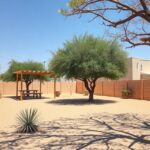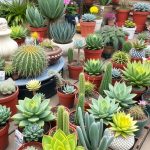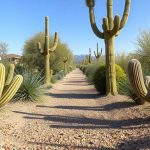If you’re looking to transform your backyard into a desert oasis, you’ve come to the right place! Here are 21 creative ideas for desert landscaping that will not only enhance your outdoor space but also make it more functional and enjoyable. With a mix of drought-resistant plants, unique hardscaping, and thoughtful design choices, these tips will help you create a backyard that thrives in the arid climate while being visually appealing.
Desert-Adapted Flower Beds

Creating a vibrant flower bed in your desert backyard can add color and charm. The image showcases a lively arrangement of various desert-adapted flowers, which thrive in hot, dry conditions. These plants not only beautify the space but are also designed to withstand the harsh climate.
Notice the variety of colors, from bright yellows to soft pinks. This diversity can make your garden feel lively and inviting. Flowers like desert daisies and California poppies are perfect choices for such an arrangement, as they are well-suited for the arid environment.
The lush green foliage provides a lovely contrast to the radiant blooms, ensuring your flower bed stands out. You can also see some larger succulent plants in the background, which add texture and height to the garden. Mixing different plant types can create a layered effect that enhances the overall look.
When planning your flower beds, consider grouping plants with similar water needs. This not only simplifies maintenance but also helps in conserving water. Mulching around the plants is another smart strategy to keep the soil moist and reduce evaporation.
Sandstone Pathways and Edging

Creating a pathway with sandstone is an inviting way to enhance your desert landscape. The warm colors of the sandstone complement the surrounding flora beautifully. The winding path draws the eye and leads visitors through your garden, making it a delightful experience. You can use various shapes and sizes of sandstone pieces to add interest and character to your walkways.
Sandstone pathways are not just visually appealing; they are also practical. They help prevent soil erosion and provide a stable surface for walking. The edges can be lined with native plants or ornamental grasses, which can thrive in arid conditions. This not only adds greenery but also helps to create a seamless connection between the pathway and the surrounding landscape.
Don’t forget to consider the layout. A curved path can create a more natural look and feel, encouraging exploration. The contrast between the hard sandstone and the soft desert plants creates a balanced aesthetic. Incorporating these elements will make your backyard a peaceful retreat that resonates with nature.
Rock Garden Landscaping Techniques

Rock gardens are a beautiful way to incorporate natural elements into your backyard. They add texture and interest, creating a serene atmosphere. As seen in the image, a well-designed rock garden features an assortment of stones and plants, blending seamlessly into the landscape.
The use of different rock sizes and colors can create striking visual contrasts. In this setup, larger boulders are complemented by smaller stones, all arranged to form a natural flow. The addition of low-maintenance plants around the rocks not only enhances the look but also provides greenery without requiring heavy watering.
Pathways made of flat stones, like the ones leading through the garden in the image, guide visitors and encourage exploration. These paths can be both practical and stylish, allowing easy access while highlighting the beauty of the landscape.
When planning your rock garden, consider the local climate and soil conditions. Choose plants that thrive in your area’s temperatures and rainfall patterns. Drought-tolerant species work well in desert landscapes, ensuring your garden stays vibrant with minimal care.
Overall, rock gardens can transform any backyard into a peaceful retreat, showcasing nature’s beauty while being easy to maintain. So, gather your stones and start designing your own rock garden!
Outdoor Living Spaces with Shade

Creating outdoor living spaces in a desert landscape can be both inviting and practical. The image showcases a cozy backyard area that perfectly illustrates this idea. With a pergola providing shade, it allows for comfortable lounging even on sunny days. The structure not only blocks the harsh sunlight but also adds visual interest to the space.
Surrounding the seating area are tall cacti and a beautiful arrangement of sunflowers, which add a pop of color and life to the setting. These plants are well-suited for desert climates and require minimal maintenance, making them a smart choice for landscaping. The use of gravel and stones instead of traditional grass creates a low-water garden that is easy to manage.
The seating area is arranged for relaxation and conversation. A simple coffee table sits in the center, perfect for drinks or snacks while enjoying the outdoors. The cushions on the chairs make it an inviting spot to unwind. This kind of setup encourages outdoor living, making it a great place for family gatherings or quiet evenings alone.
When designing your own outdoor space, consider incorporating similar elements. A shaded area, like a pergola or awning, can transform your backyard into a comfortable retreat. Use native plants to enhance the aesthetic while keeping water usage low. Overall, this backyard exemplifies how to blend style and function in a desert environment.
Succulent Garden Arrangements

Succulent garden arrangements are a fun and creative way to add life to your desert landscaping. These plants come in various shapes and colors, making them a perfect choice for creating visually appealing layouts.
In the image, you can see an inviting display of succulents arranged thoughtfully among stones. The different varieties, like the rosette-shaped succulents and taller cacti, create depth and interest. The pops of color from the succulents complement the earthy tones of the rocks, giving the space a lively yet serene feel.
To create your own succulent garden, start with a well-draining soil mix. Group different succulents together based on their size and color. Use larger stones to frame the arrangement and smaller pebbles to fill in gaps. This not only helps with drainage but also adds a decorative touch. Don’t forget to consider sunlight and water needs for each plant to thrive!
Desert Oasis with Water Features

Creating a desert oasis in your backyard is all about combining the elements of nature with a touch of tranquility. This image beautifully illustrates how water features can enhance a desert landscape. A small pond with flowing water instantly draws the eye and creates a peaceful atmosphere.
The lush greenery surrounding the water adds a vibrant contrast against the warm tones of the desert. Tall cacti stand proudly, while palms sway gently in the breeze, showcasing the unique vegetation that thrives in arid climates. The careful arrangement of plants creates a layered effect, making the space feel more inviting.
Incorporating a water fountain not only adds visual interest but also introduces soothing sounds that can make your outdoor space feel like a true retreat. The gentle splashes and ripples invite relaxation, encouraging you to spend more time outdoors. You can imagine enjoying a cup of coffee here in the morning or unwinding after a long day.
To create your own desert oasis, consider adding similar features. Use natural stones to outline the water area, and choose native plants that thrive in your climate. This approach will ensure your backyard remains a vibrant escape that’s easy to maintain. With a little planning, you can transform your yard into a serene spot that captures the essence of desert beauty.
Low-Maintenance Xeriscaping

In the image, we see a beautifully designed xeriscape backyard that highlights the beauty of low-maintenance landscaping. This approach focuses on using drought-resistant plants, which is perfect for dry climates.
The arrangement features a mix of cacti, ornamental grasses, and decorative rocks, creating a visually appealing design that requires minimal upkeep. The winding paths made of concrete and gravel invite you to explore the space while adding practicality.
Xeriscaping not only conserves water but also reduces the need for mowing and extensive garden care. The plants chosen here, such as succulents and native species, thrive in arid conditions and bring a unique charm to the backyard.
With this kind of landscaping, homeowners can enjoy an attractive outdoor space without the stress of constant maintenance. Plus, it’s a great way to support local wildlife by providing a habitat for various insects and birds.
Cacti Collection Display

Cacti can add a unique charm to your desert landscaping. They come in various shapes and sizes, making them excellent focal points in any backyard. In this vibrant display, a variety of cacti are grouped together, showcasing their interesting forms and textures.
The tall, slender cacti reach for the sky, while the shorter, round ones offer a contrasting look. This mix creates visual interest and depth in your garden. Placing them in terracotta pots not only enhances their natural beauty but also fits well with the earthy theme of desert landscaping.
One great idea is to arrange cacti in clusters, allowing you to create a mini desert landscape. You can play with different heights and colors to find a combination that reflects your style. Make sure to include some pebbles around the base of the pots to keep moisture levels balanced and to improve drainage. These little details can really make your cacti collection pop!
Artificial Turf Alternatives

When thinking about desert landscaping, artificial turf is often the first choice. It looks lush and green, even in the harsh sun. However, there are other options that can really enhance your backyard.
This image showcases a beautiful backyard with artificial turf, complemented by a variety of desert plants and decorative elements. The vibrant green lawn contrasts nicely with the natural stones and cacti, creating a welcoming space without heavy maintenance.
Instead of traditional grass, consider using ground covers like gravel or decomposed granite. These materials are low-maintenance and fit perfectly in a desert setting. They also allow for good drainage, which is essential in an area that can get heavy rainfall in a short time.
Another alternative is xeriscaping, which focuses on using drought-tolerant plants. This approach not only conserves water but also provides a unique aesthetic. You can plant succulents, native flowers, and ornamental grasses to create a vibrant landscape.
Don’t forget about hardscaping! Incorporating pathways, patios, and decorative borders can enhance your outdoor space. Using natural stones or pavers can add texture while keeping upkeep to a minimum.
Fire Pit Surrounded by Gravel

A fire pit surrounded by gravel is a cozy addition to any desert backyard. This setup creates a warm focal point for gatherings, making it a perfect spot for evening chats or roasting marshmallows.
The fire pit, made of sturdy stones, not only adds charm but also enhances safety by containing the flames. The gravel surrounding the pit is a practical choice, as it allows for drainage and minimizes fire hazards. Plus, it complements the natural landscape beautifully.
Cacti and other desert plants nearby add to the ambiance, reminding you of the desert’s unique beauty. The gentle flicker of the fire against the backdrop of these plants creates a serene atmosphere. Whether you’re enjoying a quiet night under the stars or hosting friends for a casual evening, this setup is sure to add warmth and character to your space.
Solar Lighting for Outdoor Spaces

When it comes to desert landscaping, solar lighting plays a key role in enhancing your outdoor spaces. The image beautifully captures how the warm glow of solar lights can transform a backyard into a welcoming oasis as the sun sets.
In the image, you can see various solar lights illuminating paths and accentuating the unique desert plants, like cacti and succulents. These lights not only make the space safer for evening strolls but also highlight the natural beauty of the landscape.
Solar lights are eco-friendly and require minimal maintenance. They charge during the day and automatically turn on at dusk, making them a convenient choice for backyards. You can place them along pathways, around seating areas, or near feature plants to create a cozy atmosphere.
Consider different styles of solar lights, such as lanterns or stake lights, to add character to your outdoor setup. The right lighting can turn your desert backyard into a relaxing retreat where you can unwind after a long day.
Terracing for Elevated Plant Displays

Terracing is a fantastic way to showcase plants in your desert landscaping. The image above illustrates how raised levels can create a striking visual effect. By elevating plant displays, you can draw attention to different species and their unique shapes.
In the image, you can see a series of stone terraces filled with a variety of cacti and succulents. This design not only provides structure but also allows for better drainage, which is crucial in desert environments. The use of natural stone complements the plants while creating a harmonious look.
Each tier holds different plants, adding depth and interest. The tall cacti stand proudly alongside shorter succulents and decorative rocks. This variety creates a lively scene that is both beautiful and easy to maintain.
When planning your own terraced garden, consider using materials that blend well with your plants. Think about how heights can enhance the overall design. Terracing can transform an average backyard into a delightful space that invites exploration and appreciation of nature.
Desert-Themed Vertical Gardens

Vertical gardens can add a unique touch to your desert landscaping. They turn a plain wall into a vibrant showcase of plants, bringing life to your backyard. The image shows a creative arrangement of various plants, from succulents to leafy greens, all thriving in a structured setup.
This type of garden is not just about aesthetics; it’s also a space-saver. If you have limited ground space, stacking plants vertically allows you to enjoy greenery without taking up too much room. It’s a fun way to experiment with different plant combinations and textures.
Using a mix of cacti and succulents can create visual interest while also being low-maintenance. The materials used in the vertical garden can also enhance the overall design. Opting for dark containers against a light wall can make the colors of the plants pop even more.
Consider adding a drip irrigation system to keep your plants healthy without much hassle. These gardens are a great way to enjoy the beauty of nature in a compact form, making them perfect for desert-themed backyards.
Colorful Pots and Planters

Colorful pots and planters add a vibrant touch to any desert landscaping. In the image, we see a variety of pots, ranging from terracotta to painted designs, perfectly complementing the unique shapes and colors of the cacti and succulents planted in them.
The mix of different sizes and styles brings depth and interest to the garden. The tall, spiky cacti contrast beautifully with the round, flowering varieties. This variety keeps the eye moving and invites exploration of each plant.
Choosing pots with bright colors can enhance the overall aesthetic. They create a cheerful atmosphere, especially in a desert setting where greenery is often sparse. Planting colorful flowers, like the pink ones in the image, can further brighten the space and attract pollinators.
Arranging these pots at different heights can create layers, making the garden feel more dynamic. Consider grouping pots in clusters for a more cohesive look. This not only emphasizes the colors but also makes maintenance easier.
Wildlife-Friendly Desert Gardens

Creating a wildlife-friendly desert garden can be a rewarding way to enhance your outdoor space. The image shows a beautifully designed desert landscape with a stream winding through various native plants and cacti. This kind of setup not only looks appealing but also supports local wildlife.
Incorporating native plants is key. These plants are well-suited for the environment and provide food and shelter for local animals. The stream in the image acts as a water source, attracting birds and other wildlife that rely on hydration. By adding rocks and logs, you can create hiding spots for small creatures, making your garden a safe haven.
Consider planting flowers that bloom at different times of the year. This ensures that there is always something in bloom, providing nectar for bees and butterflies. The mix of textures and colors in the garden can also create visual interest while benefiting the ecosystem.
Remember, maintaining a wildlife-friendly garden doesn’t have to be labor-intensive. Simple features, like a muddy area for birds to take a bath or a few native shrubs, can make a big difference. Your garden can thrive while also becoming a place where wildlife can flourish.



